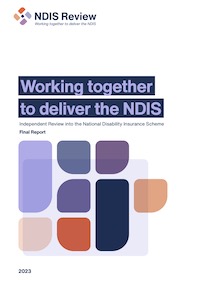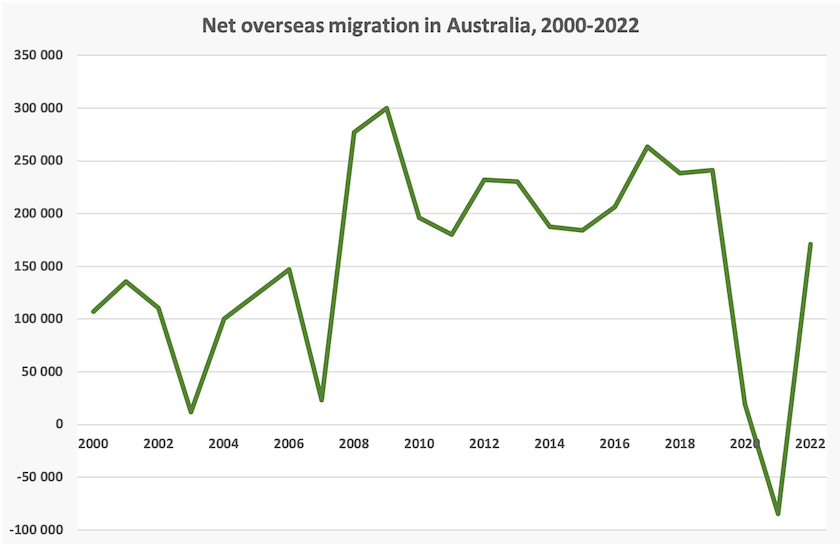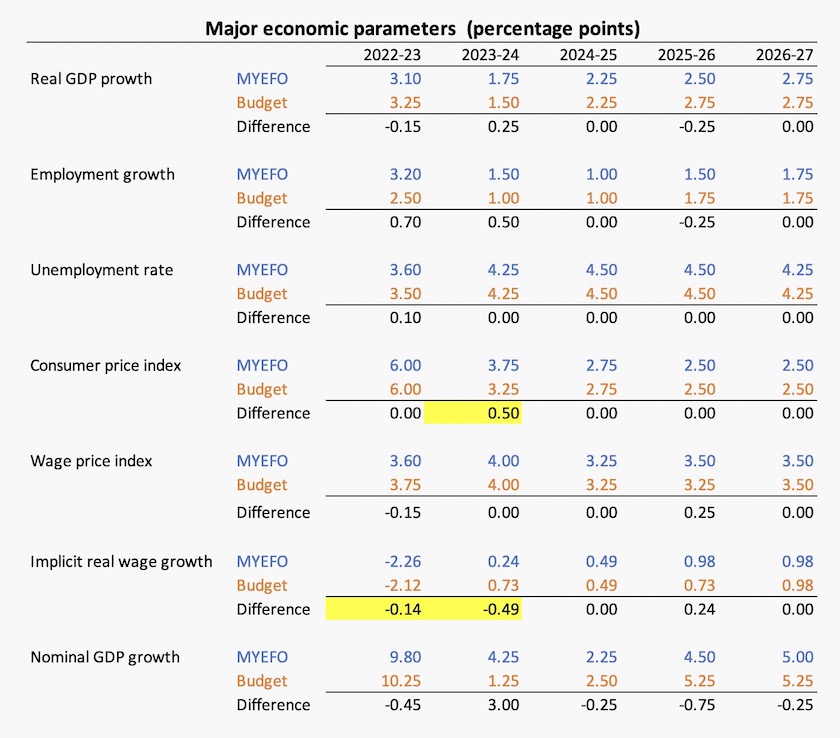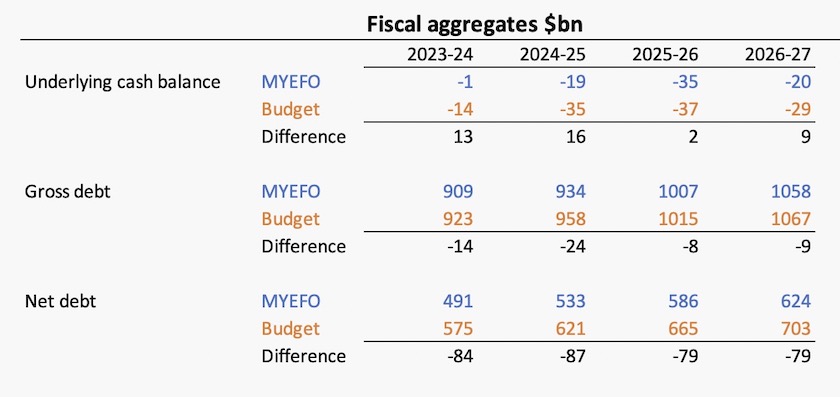A swag of policies for the end of year
The NDIS reined in
In a nutshell, the NDIS review is about controlling its fiscal cost, removing incentives for cost-shifting between the Commonwealth and states, improving its administrative efficiency, ensuring that assistance is directed to where it’s most needed, and making sure no one falls through the gaps between programs. That’s a fairly typical set of recommendations for a well-directed review of human services programs.

For specifics, one can turn to the webpage of the NDIS Review but it is complex to navigate. Bill Shorten’s webpage summarises some of the review’s main points. It describes the idea of “foundational supports” – support through generally-available programs in contrast to individualized packages under NDIS, the requirement for providers to be registered, a fairer approach to housing, and greater attention to early childhood intervention.
Perhaps the clearest presentation of government policy is in Laura Tingle’s 9-minute interview with Shorten. This is a 730 segment linked from Tingle’s short political summary of the review.
Tingle’s political analysis is that the Commonwealth has “a tricky message”, because it has to bring the NDIS itself back to its core services, a scheme “supposed to deal with those people with the most severe intellectual, sensory, physical or psychosocial disabilities” – around 0.6 million people. There are another 3.9 million people with some level of disability who need services “that don't really exist at the moment or only exist in a haphazard way”. The work of developing and providing those services, in a 50:50 cost-sharing arrangement with states, is only in its early stages.
Shorten is upbeat about the arrangement with the states. He said of the National Cabinet meeting the day before, “yesterday for a moment in time federation worked”.
Sam Bennett and Hannah Orban of the Grattan Institute have a Conversation contribution explaining the spilt between “foundation support” (for the 3.9 million) and individualized support (for the 0.6 million): What’s the difference between ‘reasonable and necessary’ and ‘foundational’ supports? Here’s what the NDIS review says. They explain the funding deal between the Commonwealth and the states, confirming that while the states have some obligations to preserve foundation services, most of the growing (but more controlled) fiscal demand of the NDIS will fall to the Commonwealth.
The Conversation also has a collection of opinions on the NDIS changes from five health experts: Recommendations to reboot the NDIS have finally been released. 5 experts react. Their assessments are generally positive, particularly in relation to the way the recommendations, if implemented, will close gaps in service delivery. There is some misgiving about the requirement for providers to be registered: some non-registered providers can provide flexible and low-cost services, and registration, in itself, does not rid the scheme of thieves. They are highly positive about the re-direction of NDIS criteria from applicants’ medical diagnosis to an assessment of their functional impairment. They note that NDIS as it exists is bureaucratically complex, and warn against any reform developing its own layers of complexity.
Also writing in The Conversation Di Winkler of La Trobe University comments on how the NDIS Review, and the findings on the “Royal” Commission on disability, could improve the housing conditions for people with disability. She notes that group housing for people with disability has generally been a failure: Taken together, the NDIS review and the royal commission recommendations could transform disability housing.
It’s reasonably safe to suggest that the NDIS will never satisfy all stakeholders’ demands. It’s an open-ended program, and as general standards rise our idea of what constitutes reasonable standards for people with disabilities will also rise.
Immigration – repairing a neglected system
A re-directed immigration policy is probably the most significant initiative the Albanese government has taken so far, but it will be many years before the effects are fully manifest.
Immigration has become a major issue in the USA and in many European countries, where for a mixture of concerns strong anti-immigration movements have emerged. People can perceive immigrants as being responsible for unaffordable housing, pressure on government services, an elevated level of crime, and a loss of national identity. Even when there is no substance to these concerns opportunistic politicians on the right can tap into them, opening up racial and ethnic divisions.
Australia’s situation is somewhat different, in that multiculturalism has become part of our identity – “migration is central to who we are” to quote Migration Minister Clare O’Neil – but there are perceptions that immigration is a driver of our housing shortage. Peter Dutton has demonstrated, as John Howard did before him, that the Coalition is always ready to blow the dog whistle to mobilize the racist far right.
The government’s changes
In announcing a major re-direction of our migration program, the government is trying to head off the possibilities of an anti-immigration movement developing in Australia.
In terms of numbers the government’s changes are modest – they won’t do anything significant to change the demand for housing – but they carry the message that the government will oversee a smaller and better-managed migration program and bring numbers back to normal.

Immigrant’s suitcases, Bonegilla, by Yvette George
While the absolute numbers may not change much, the composition of immigration could change significantly. Minister Clare O’Neil explains on the ABC’s 730 program that the system is “back-to-front”. While it has been easy for people to come in the back and side doors by enrolling in shonky education courses and moving into low-paid unskilled jobs, changes implemented by the Coalition government made the front door of permanent migration for skilled people very difficult to enter. That will be turned around.
Probably the clearest explanation about changes to immigration policy is in a 12-minute interview with Martin Parkinson on Radio National: “A decade of wilful neglect: migration strategy unveiled”. Parkinson is the lead author of the Review of the Migration System, which reported to the Commonwealth in March this year. He says that the reviewers came across a system that was “absolutely and utterly broken”, because it had suffered “a decade of almost wilful neglect”.
While media attention has focussed on the numbers of immigrants (plotted below), a crackdown on student visas, and a speeding up of visas for skilled immigrants, Parkinson’s main point is that our migration program has drifted along opportunistically, without its objectives being articulated. This has meant that it has not integrated with government programs on service delivery, infrastructure and housing.

A strong point made by Parkinson and others is that we have about 2.3 million people (9 percent of our population), best described as “permanent-temporary” immigrants. They are not on a pathway to official permanent residence or citizenship, but they keep extending their stay, moving from one visa to another or overstaying. With such tenuous presence many are subject to exploitation, particularly underpayment of wages in the grey economy.
This development is explained in detail by Georgina Roberts on the ABC website: Three key takeaways of the federal government's migration. She provides a graph on the composition of immigration, showing that over the last ten years there have been proportionally more and more temporary visa holders, while the number of permanent visa-holders has fallen.
One doesn’t need a degree in sociology or politics to understand the consequences of allowing the development of a large low-skilled, easily identified, immigrant underclass.
Changes for students
One common interpretation of the changes is that it will be harder for students to come to Australia, but that’s a simplification. Writing on the ABC website, David Speers describes the composition of students coming to Australia, including those who have come in the post-Covid surge. The government’s changes mean that the system will be less accommodating for those coming for low-quality courses, generally offered by private training institutions which have become de-facto an easy path to migration. But the government hopes to make the immigration system more accommodating for students who come to do professional undergraduate and graduate courses and who may be enticed to stay: New migration strategy aims to reduce Australian arrivals to “sustainable level”.
Writing in The Conversation Rachel Stevens of Australian Catholic University explains details of visa changes as they apply to international university students. There is to be a rise in the requirement for English-language proficiency, and there is a new limit on the number of hours of paid work students can do: The government is bringing immigration back to “normal levels” but cuts are not as dramatic as they seem. She notes that while the review has been strong on workforce needs, it is comparatively light on covering issues to do with family reunion and refugees.
Closing the door on people traffickers
In a short (4-minute) interview on the ABC, Sally Sara asks former Immigration Department Deputy Secretary Abul Rizvi if the government’s reforms will be effective in cracking down on immigration scams. Rizvi reminds us that over the last decade we have experienced the largest human trafficking scam in our history, while the government was cutting back on immigration compliance activity. When the Department of “Home Affairs” was created (whatever that name means), the expertise and experience the old Immigration Department had accumulated in detecting scams was lost.
Consequently there is now a growing number of failed asylum-seekers and others who are here without visas and who have to work illegally in order to survive. This has been a common experience in Europe and North America, but not in Australia until recently. He is highly critical of the Coalition government for having let this happen, and is also critical of the present government for doing too little to rectify it: he believes that the $150 million the government has allocated to cleaning up the system is too little for the task. Rizvi also reminds us that it was on Peter Dutton’s watch that it became difficult for skilled immigrants to enter the market.
Did the Coalition fail, or did it really succeed?
Most commentators attribute the growth of a large “permanent-temporary” pool of underpaid immigrants to the incompetence of the Coalition. It would be hard to gainsay that view: the Coalition went out of its way to strip administrative expertise out of government, and was well-disposed to privatized education providers. But we should also remember that a core aspect of the Coalition’s economic policy has been to suppress wages. Successive Coalition administrations – Howard, Abbott, and Morrison – have seen national competitiveness in terms of a low-wage structure. A pool of underpaid workers, out of the reach of trade unions, is an ideal mechanism to keep the whole workforce disciplined.
It is notable that in spite of the Coalition’s failure to control our borders, the most recent Resolve Poll reveals that when voters are asked which of the two main parties performs better on “national security and defence”, 37 percent of respondents nominate “the Liberals”, while only 26 percent nominate “Labor”. This is testament to the enduring power of lies and confected impressions during the years of Dutton’s relentless propaganda campaign as “Home Affairs” Minister.
Fair Work Legislation – wage theft, labour hire, and why we will pay a little more for our café latte.
Much of the government’s Fair Work legislation, including provisions relating to gig workers, casual workers and road transport workers, is still under consideration in the Senate, subject to further committee consideration in the new year. What eventually passes will be shaped by Labor and crossbench Senators, particularly Jacqui Lambie and David Pocock, the Coalition having dealt itself out of relevance by opposing all aspects of the Fair Work reforms.
Important portions relating to wage theft and companies’ use of labour hire companies to drive down wages have been passed. Details of these and other provisions are in Minister Tony Burke’s media release, Closing loopholes, and in a media release on the ACTU website: Early Christmas present for millions as a significant part of the Closing Loopholes Bill passes.
These reforms have been under consideration for some time, having been flagged in the government’s Same Job, Same Pay consultation paper, released in April this year.
There aren’t many voices defending wage theft. Although there are still some thugs in industries such as horticulture and hospitality ruthlessly exploiting immigrants, there are many more employers in these same industries paying proper wages who don’t want to be undercut in these highly competitive industries.
In relation to labour hire companies, the intention of the legislation is captured in the “same job, same pay” aphorism. The purpose is to prevent companies paying workers employed through labour hire firms less than is paid to permanent workers doing the same job, where an enterprise agreement is in place. The ACTU calls out mining companies and Qantas as having used labour hire businesses as ways to undercut wages.
These provisions have evoked protest from some industry associations, illustrated in the press release Deep flaws remain in “Closing Loopholes” bill by the Australian Industry Group. There is a website findabetterway.com.au with videoclips attributed to the Business Council of Australia, the National Farmers Federation, the Minerals Council of Australia and other lobbies. They’re worth a glance to get an impression of their emotive messaging. It’s telling that the Minerals Council clip depicts two blokes tasked with digging a deep trench with shovels, one working hard while the other is slacking. Are they telling us that if they can keep wages low enough companies won’t bother investing in trench-digging equipment?
In spite of the industry associations’ talk about “deep flaws” and their use of the slogan “findabetterway”, there is no explanation of the nature of these flaws, nor are there any suggestions about what may be “a better way”.
The message in their advertisements, that employers cannot offer premiums for skills or performance, seems to lack substance: the Australian Payroll Association specifically mentions considerations for “experience, qualifications and performance levels”.
Closing the labour-hire loophole will require firms to revert to paying wages as negotiated in enterprise agreements and awards. Some, such as highly profitable mining enterprises, should have plenty of capacity to absorb the cost. Some firms may be prompted to invest in equipment to replace labour: such capital deepening will do its bit in lifting labour productivity. And in some intrinsically labour-intensive industries, such as horticulture, there will be price rises: if the middle classes have to pay a little more for their food to support farm workers that seems to be a just outcome.
The much-awaited MYEFO
The Mid-Year Economic and Fiscal Outlook is well summarized in the headline on the post by the ABC’s Brett Worthington: Federal government budget bottom line improved but offering few signs of real wage growth in 2023-24.
Economic outlook – little has changed
Although most media attention, and the government’s spin, is about the fiscal outcome, the most important aspect of the MYEFO lies in its economic forecasts. They don’t vary greatly from those made in the May budget – a point worth stressing, because it’s only in the last few weeks that fear of a world-wide recession has abated. It’s a case of no news being good news, because the Australian economy does seem to be picking up, albeit from a low base. That’s the message from the MYEFO, confirmed in an ABC interview with Justin Wolfers.
The economic forecasts and projections are shown in the table below, with a comparison with those made in the May budget, and meaningful differences highlighted.

Those differences show that it will take longer for the CPI to come down to the two-to-three percent comfort range, and that there will be poorer than expected real wage growth. But as Wolfers stresses, there will be real wage growth – by 0.24 percent this year, and by 0.5 to 1.0 percent growth in the following years. That’s better than the stagnation over recent years, and the 2.26 percent fall last year, particularly if there is some prospect of interest rates falling.
Fiscal outlook – banking savings
To quote the spin in MYEFO:
The Government’s responsible economic and fiscal management delivered Australia’s first surplus in 15 years in 2022–23, and is helping to restore Australia’s fiscal buffers. Smaller deficits and lower debt are now forecast in every year of the forward estimates compared to the 2023–24 Budget.
These fiscal projections are shown below.

As a percentage of GDP the cash deficit is forecast to peak at 1.2 percent in 2025-26, much lower than the levels in other “developed” countries, which are more in the range of 2 to 5 percent of GDP (6.3 percent in the USA.)
The $13 billion deficit reduction this year results from a $16 billion increase in tax receipts, resulting from high commodity prices, stronger than expected employment and rises in nominal wages, pushing people into higher tax brackets. This is partially offset by a $4 billion increase in outlays.
Net interest payments are forecast to level out at about $22 billion a year, pretty well in line with the May budget, suggesting that even though households may have been taken aback by the RBA’s aggressive moves, the government hasn’t been surprised.
Steve Bartos has a concise summary of the MYEFO’s fiscal forecasts in The Conversation: There’s a glimmer of hope in the mid-year budget update, but inflation is still a big challenge.
The politics of MYEFO
It is clear that the government has found it necessary to emphasize the fiscal numbers in the MYEFO, as if no aspect of economic management is more important than fiscal bookkeeping – an obsession that has diverted public attention away from the broader task of economic structural reform.
Estimating a $1.1 billion deficit for the current year must have been a computational challenge for Treasury officials. One clue of their working is in the MYEFO assumption that the iron ore spot price will decline to a price of $US60/tonne: it is more like $US120 at present and markets are fairly bullish about its prospects. The surprise of a fiscal surplus will be held over until the next budget.
Writing in The Saturday Paper – Chalmers’ budget balancing act – John Hewson describes the political environment in which the government is having to manage the economy:
Labor’s budget management is high on the agenda of the Coalition and its media mates, who always have their eyes on the next federal election. The situation is ripe for a populist onslaught against the Albanese government. The overarching strategy of the opposition under Peter Dutton is informed by its obsession with bringing down the government – obstructing its efforts and casting doubt on its competence at every turn. This has become an ugly and unedifying spectacle, ignoring available evidence and policy substance at the expense of our national interest. By comparison, Prime Minister Anthony Albanese has been attempting to focus more on governing for the medium term, to move beyond these short-term political games.
In the same article Hewson, while commending the government for its economic and fiscal management, puts a strong case for bold tax reform, and seriously questions the economic wisdom of proceeding with the Stage 3 tax cuts, because they’re inflationary and unaffordable. The problem faced by the government is that abolition of these cuts, or any substantial modification, would evoke a shrill “broken promise” accusation from Dutton and his backers in right-wing media.